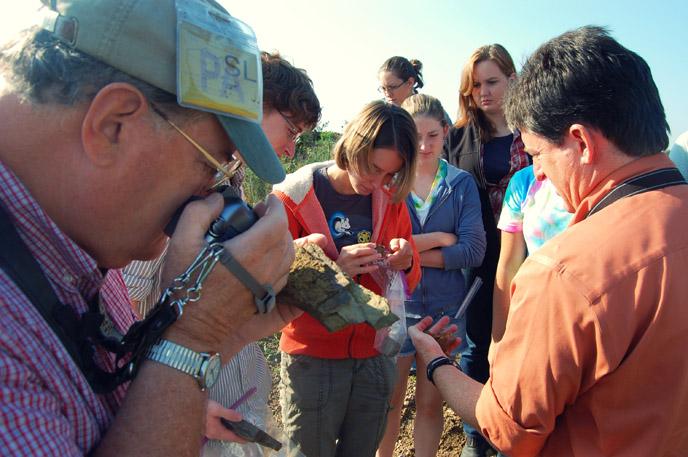King Phillip Came Over for Good Soup

Group examines fossil specimens
On a rock face in Perry County, Pa., students see how paleontology is done
Photo and text by Tony Moore
Outside of Newport, Pa., a white Dickinson van bangs and thumps up the rutted dirt road leading from the bottom of the quarry to the top. It's just started its climb, and the view from the bottom is impressive enough that everyone in the van gasps a little: The rock face is massive, extending straight upward toward the clear blue October sky. A formation of turkey buzzards wheels in the sky, their shadows moving across the shale surface of the cliff.
Finally reaching the top, where the view is even more impressive, Joseph Priestley Professor of Natural Philosophy Marcus Key, Visiting Instructor in Biology Gene Wingert and their 10 students climb out of the van, ready to hunt for fossils.
"We're looking for crinoids and brachiopods," Key says. Both, he notes, are marine animals. But take a quick look at a map of landlocked Newport and a question might quickly come to mind: Why is Key taking his students here to look for the fossilized remains of marine animals, to a site that is more than 190 miles from the Atlantic Ocean?
"When Africa collided with North America, during the Upper Devonian period, all these rocks were folded up into the Appalachian Mountains and ended up here—about 375 million years ago," Key explains. "So these rocks at this elevation were not actually formed here."
How paleontology is done
Standing at the top of a quarry overlooking the expanse of Perry County fits in well with what Eller Mallchok '15 was looking for in her Mosaic experience."The aspect of doing hands-on fieldwork outside the classroom was very cool and unique to me," she says. "It was, as admissions would love to hear me say, distinctly Dickinson." She laughs, but the truth in her statement comes through. "To me, it really is. It's a program and an opportunity that is distinctive to the school and one that I wouldn't want to give up."
The students split up and set to examining rocks, breaking them apart with rock hammers or simply crushing them, layer by layer, with their bare hands. They then identify the pieces, either telling or asking Key what they've found, down to the phylum level. Wingert videotapes everything they find for a DVD he's compiling. "King Phillip Came Over for Good Soup," Key says, reminding the students of one of the more common mnemonics for remembering the classification system for Linnaean taxonomy.
"This is how paleontology is done," Key tells the students, each of them holding dusty rocks. "What were we're focusing on is paleoecology: trying to understand the environment these creatures lived in. If we were going to do an evolutionary study, how would we attack this outcrop differently?"
And the impromptu lesson, at the top of this vertigo-inducing cliff, turns into a question-and-answer exercise on the scientific process and a lesson in how to solve paleontological mysteries. The session ends with a reality check of sorts.
"Do you think any of these specimens would make it into the Smithsonian?" Key asks. The gathered students answer as one: "No."
But a voice comes out of the crowd: "Do you have anything in the Smithsonian, Professor?"
"Do I?" Key turns slowly and smiles. "Yeah."
Learn more
- The Mosaic goes to the Chesapeake Bay in Crabbing with Ooker
- Look for birds of prey with the Mosaic
Published July 3, 2013